- Detalhes
- Read Time: 9 mins
7.1 - Making a home
Now we have animals, plants and electricity, perhaps we should set up somewhere to live where we can cook, wash, rest and generally do all the things the HUD (in health mode) requires us to do!
In the Household platform (box 8) you will find various items that you can use to help set up your home and look after your health and well-being. Also you will find some home cooking items in the Food and drink platform (box 7)
7.2 - Surfaces
Most food items that you make are set to look for a ‘surface’ to go to. If you make something in the oven or hob etc., when it is complete it will look for the surface called SF Table and if it finds one in range (approx 20m radius) it will automatically set itself there (and the table cloth will appear!)
Surfaces allow you to place items ready for use – in the case of the table you can sit on a chair (which will increase your energy level) and then use the food item to decrease your hunger/thirst etc. Although you are sort of storing an item on a surface, unlike being in storage, items on surfaces will still age. Items that contain the surface feature may have more than one ‘surface’ – the table is an example of that as it can hold up to four items.

For more information on using and customising surfaces, refer to Chapter 13
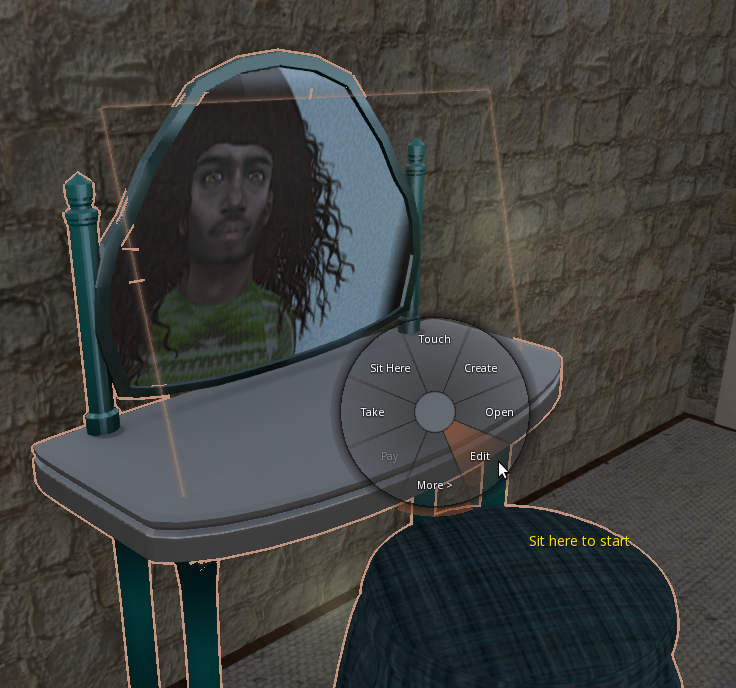
7.3 - Change the SF Dresser mirror reflection
When you use the SF Dresser, a ‘reflection’ image is shown on the mirror. This is just a projected image and you can change it as follows:
First you will need to click on the dresser, select Do... and select one of the task options (e.g. Makeup) and add required items - this will then show the reflection. Don’t sit but instead right click the dresser and select Edit
Now you are in edit mode, click on the Features tab then click on the Edit linked option to select it.
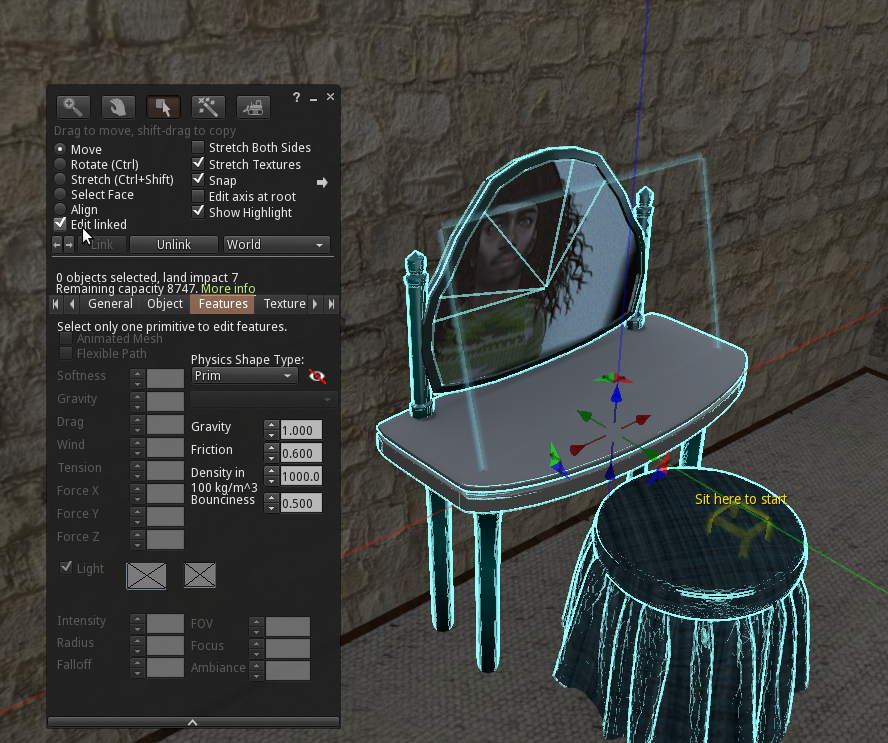
Now left click on the invisible prim to select .
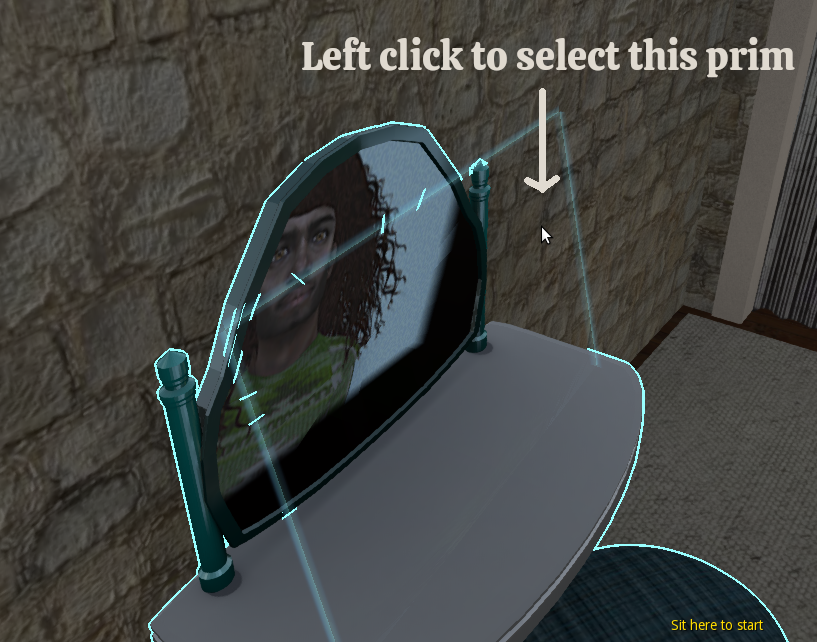
If you have selected the correct prim you will see there is now an image showing and also the Light option is selected.

You can now left click on the image and the texture picker window will show to allow you select the image you wish to use.
Select your image and then close the edit window by clicking the top right X button.
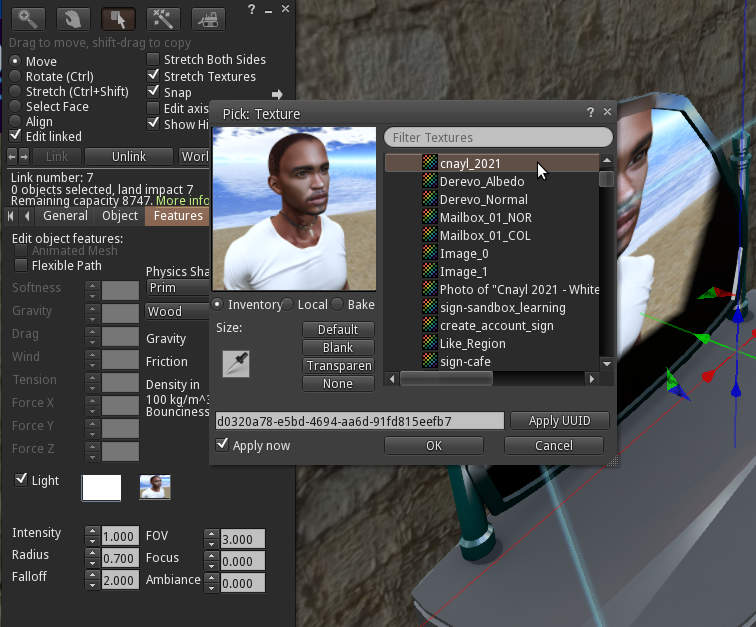
Now sit on the dresser to complete the task.
Once the task is complete the mirror will go back to the blank screen but in future will use your new image each time you do a task on it.
7.4 - Add Health Mode to your furniture
As well as all the items available in the Quintopia boxes, it is also possible for you to add health mode support to any items of furniture etc. that you already have.
In the household platform (box 8) there are 4 kits that you can use covering the common systems of PMAC, MLP, sit scripts and also a ‘cover’ that you can place over any bed.
Converted items will send a progress message to the HUD display during use and then send the configured ‘health’ values at the end of the set time period.
(a) Config notecard
The configuration is the same for all of the kits:
# # All the following are optional overrides to the default values of: # TIME=120 # HYGIENE=99 # HEALTH=30 # BLADDER=50 # ENERGY=30 # AUTO_END=1 # How many seconds to run the action TIME=120 # # How much to change well-being when time is up (can be positive, negative or zero) HYGIENE=99 HEALTH=30 BLADDER=0 ENERGY=30 # # Set to 1 for actions to end when times up, or 0 to have the avatar repeat cycle until stopped by manually selecting to stand AUTO_END=1
The default values in the initial comments will be used unless overridden in the notecard, so you only need specify those that you wish to have a different value from the default.
If AUTO_END is set to 1 then you will automatically stand at the end of the specified time interval. If you set it to 0 then you will remain seated and the values for health, hygiene etc. will be sent to your HUD after every time interval. You manually select Stand to end the actions.
(b) PMAC Addon kit
This kit allows you to add the health mode functions to anything that uses the PMAC (Paramour Multi-Animation Controller) system. It consists of the script addon-pmac_health and the config notecard and also a notecard called sfp
You place these items into your PMAC furniture in the following order:
-
Add the notecard sfp to the main prim of your furniture
-
Add the notecard config to the main prim of your furniture
-
Edit the config notecard if you wish to change any settings
-
Add the script addon-pmac_health to the main prim of your furniture
If you see a 'bad password' message, re-set all scripts.
Your PMAC furniture should now operate as it did before, but when people are ‘seated’ their HUD will receive the health values as configured.
Information on the PMAC system can be found online at https://github.com/uriesk/pmac
(c) MLP Addon kit
This kit allows you to add the health mode functions to anything that uses the MLP (Multi Love Pose ) system. It consists of the script addon-mlp_health and the config notecard and also a notecard called sfp
You place these items into your MLP furniture in the following order:
-
Add the notecard sfp to the main prim of your furniture
-
Add the notecard config to the main prim of your furniture
-
Edit the config notecard if you wish to change any settings
-
Add the script addon-mlp_health to the main prim of your furniture
If you see a 'bad password' message, re-set all scripts.
Your MLP furniture should now operate as it did before, but when people are ‘seated’ their HUD will receive the health values as configured.
Information on the PMAC system can be found online at http://wiki.secondlife.com/wiki/MLPV2_Tutorial
(d) Sit/Poseball Addon kit
This kit allows you to add the health mode functions to anything that uses one or more sit scripts (sit target). It consists of the script addon-sit_health and the config notecard and also a notecard called sfp
You place these items into your MLP furniture in the following order:
-
Add the notecard sfp to the main prim of your furniture
-
Add the notecard config to the main prim of your furniture
-
Edit the config notecard if you wish to change any settings
-
Add the script addon-sit_health to the main prim of your furniture
If you see a 'bad password' message, re-set all scripts.
Your furniture should now operate as it did before, but when people are ‘seated’ their HUD will receive the health values as configured.
Information on the sit target system can be found online at http://wiki.secondlife.com/wiki/LlSitTarget
(e) SF Bed (cover)
This is just a flat prim that contains all the functionality expected of a bed. Just position it over your bed to use. You can set it to transparent and phantom.
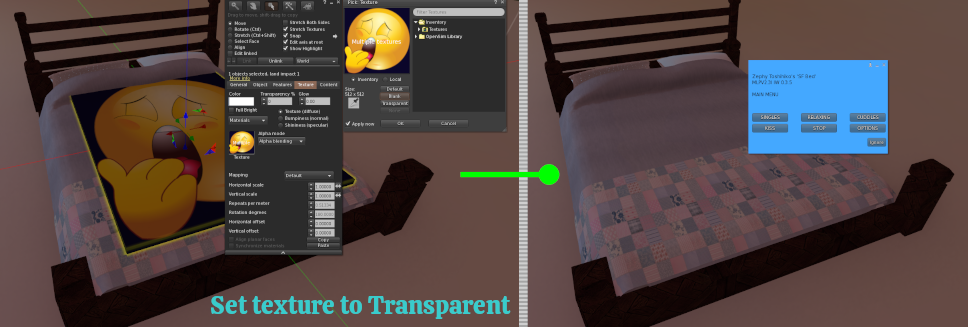
The cover uses the MLP system so you can edit the config notecard etc. As per the MLP instructions.
7.5 Cleaning, Cooking, Relaxing
By now you have probably noticed that the HUD, when in health mode, requires you to wash, visit the lavatory, eat, drink etc
A good way to make sure you can keep healthy is to set up your house with the areas/rooms such as:
(a) Kitchen
Great items here are cooker, hob, fridge, storage, table and chairs etc. Make sure to have the table within a 20m radius of where you prepare food so that the finished items will automatically go to the table.
(b) Bathroom
You can wash with the sink, shower or bathtub. A lavatory is also a welcome addition unless you prefer an outdoor privy!
(c) Living room
Somewhere to just sit and relax is a great idea. When your energy is low, just sit on a chair to let it build back up again. Lighting a fire also adds to your well-being. Some people like to put a few crafting items here as well.
(d) Bedroom
Somewhere to sleep and recharge your energy and a place perhaps to store pillows, duvets and the like. And if you are not in a G rated region, perhaps a place for a bit of woohoo!

This work by Cnayl Rainbow is licensed under a Creative Commons Attribution-NonCommercial-ShareAlike 4.0 International License.
Based on a work at https://satyrfarm.github.io/
- Detalhes
- Read Time: 12 mins
13.1 DESENVOLVA OS SEUS PRÓPRIOS ITENS
Uma das grandes vantagens do sistema 'SatyrFarm' é o facto de ser totalmente de código aberto e concebido para ser facilmente alargado e personalizado. O resto deste guia é sobre como personalizar os objectos existentes e criar os teus próprios objectos. Estamos sempre ansiosos por adicionar novos itens à versão VivoSim do sistema, que está sempre a crescer, por isso não te acanhes, se fizeres algo novo, estás à vontade para o partilhar!
Provavelmente a maneira mais fácil de começar é modificando itens existentes, mas você é livre para usar os scripts em outros itens, mas nós recomendamos que você faça uso dos últimos scripts do repositório VivoSim em https://github.com/punyauk/VivoSim, especialmente se você planeja compartilhá-los. Também deve garantir que cada item e todos os itens que ele contém no seu inventário recursivo devem ser full perm, caso contrário o seu produto não funcionará para outros utilizadores.
13.2 ARMAZENAMENTO
(b) O botão Novo stock
Pode utilizar este botão para procurar produtos próximos e tentar adicioná-los à unidade de armazenamento. Para tal, a unidade de armazenamento verifica outros locais de armazenamento que tenham o modo de partilha ativado (a predefinição) e também as unidades de troca existentes na região. Se o produto for encontrado em qualquer um desses locais, será adicionado a esta unidade de armazenamento. Esta é uma forma fácil de alterar o conteúdo de uma unidade de armazenamento, mas está limitada à possibilidade de adicionar produtos que já existam noutro local da região.
Note que o item precisa de ter P; no início da descrição para ser reconhecido como um produto. Este é o estado normal para qualquer produto que tenha sido retirado de uma máquina, fábrica, etc. Mas se se tratar de um artigo novo, basta definir a descrição como P;
(b) Adicionar um produto ao barril do armazém SF
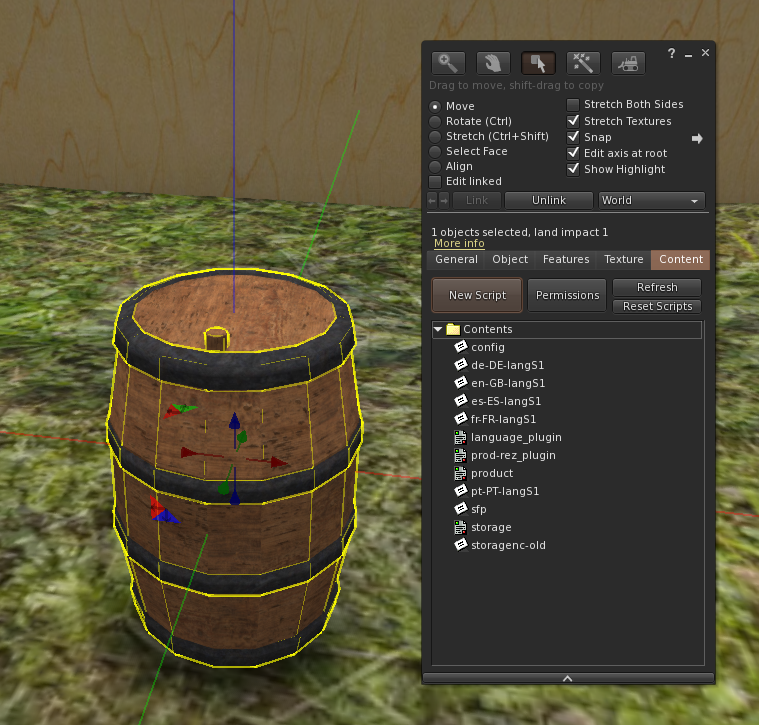
Provavelmente, a forma mais fácil de armazenar um novo produto criado por si é modificar o barril existente da SF Store. Também pode adquirir algumas caixas de armazenamento "modelo" vazias na loja Mintor. O script de armazenamento configura-se automaticamente para qualquer produto no seu inventário, por isso, se tiver um novo produto, basta colocar uma cópia dentro da SF Store.
Exemplo
Vamos começar por rezar um dos barris de armazenamento simples. Clica com o botão direito do rato para editar e dá uma vista de olhos no separador Conteúdo. Vais ver vários guiões e cartões de notas que são abordados em mais pormenor no capítulo 14.

Por enquanto, tudo o que precisamos de fazer é arrastar o nosso produto do nosso inventário para o conteúdo do barril de armazenamento. Por exemplo, temos um artigo de pétala de dente-de-leão que queremos armazenar, por isso arrastamo-lo do nosso inventário para a área Conteúdo.
Depois de arrastar o item, clique no botão Reiniciar Scripts e verá que agora tem um local de armazenamento para as pétalas de Dandelion!
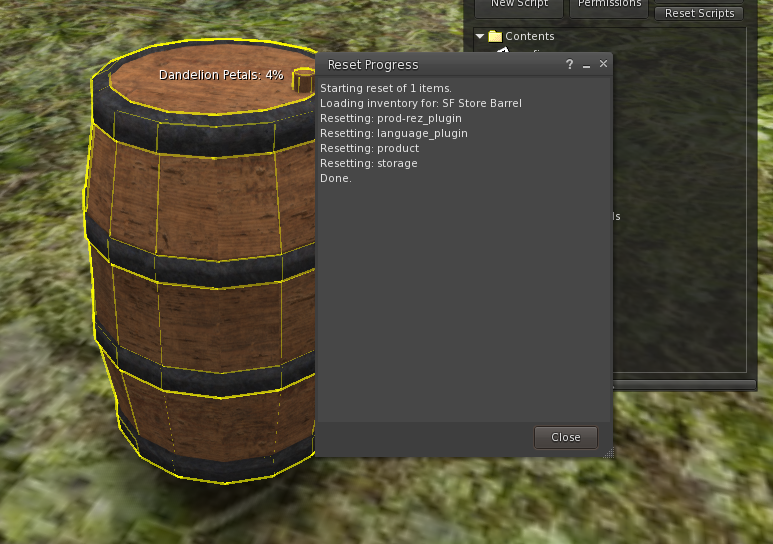
Para além do tipo de armazenamento de um único item que acabámos de criar, podemos criar unidades de armazenamento que contêm vários itens. Há dois tipos que podemos criar: o primeiro mostra os níveis de todos os itens num bloco de texto flutuante. O segundo permite-nos mostrar vários textos flutuantes para cada item na loja.
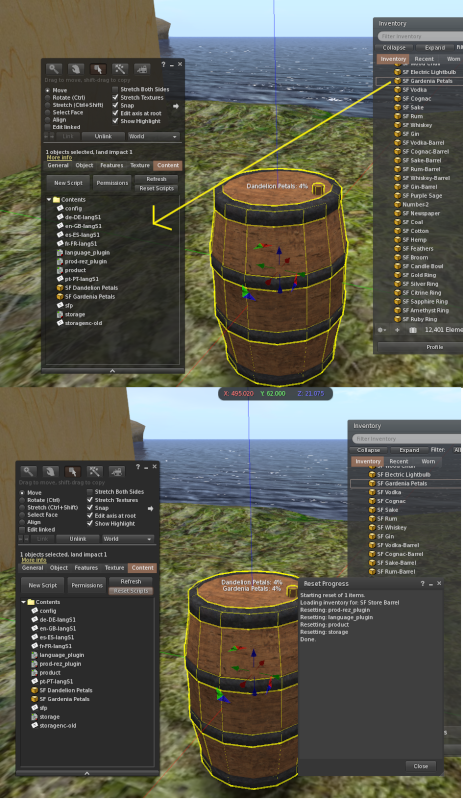
Vamos começar com o tipo de texto flutuante único, uma vez que tudo o que precisamos de fazer é arrastar outro produto para o conteúdo do nosso armazenamento existente. Por exemplo, vamos adicionar pétalas de gardénia à loja.
Clique com o botão direito do rato e selecione editar e, novamente, vá para o separador Conteúdo e arraste para lá o novo item (pétalas de gardénia, no nosso exemplo) e, em seguida, clique no botão Repor scripts e verá que agora temos uma loja para dois itens.
Podemos adicionar tantos itens quantos quisermos a este tipo de armazenamento, mas é claro que, se adicionarmos muitos, pode ser difícil ler a partir de um grande bloco de texto flutuante, para além de que o número de caracteres no texto flutuante é limitado, pelo que pode não conseguir listar todos os itens.
Podemos utilizar outro tipo de armazenamento que nos permite ter vários textos flutuantes para cada item - provavelmente já viu algumas das unidades de armazenamento que o fazem, como o SF Basic Storage e o SF Storage Rack.
A criação deste tipo de armazenamento segue o mesmo processo que já efectuámos, mas com alguns passos adicionais.
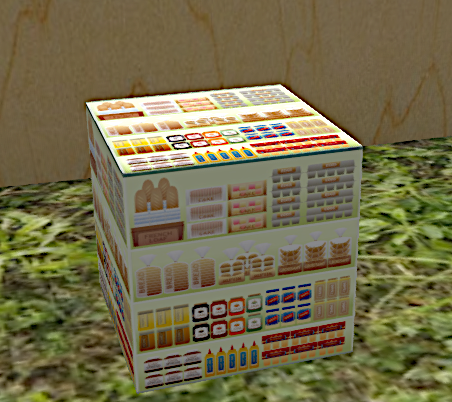
Começaremos com o modelo de armazenamento SF , que é um cubo simples que pode ser utilizado como ponto de partida para os seus próprios projectos. Para este exemplo, utilizaremos novamente as pétalas de Dandelion e Gardenia para vermos como este tipo de armazenamento se compara ao anterior.
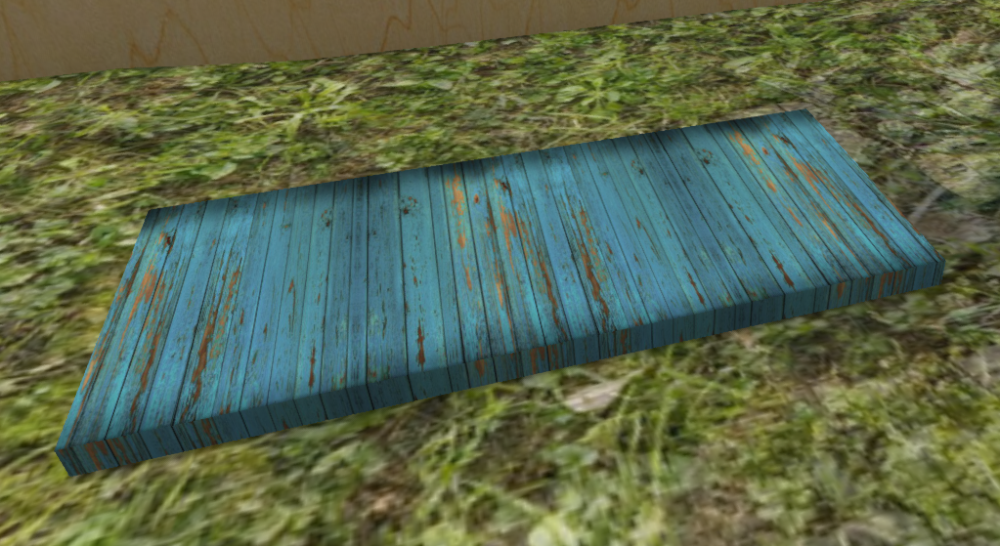
O design do sistema de armazenamento depende muito de si, mas neste caso vamos fazer uma prateleira de armazenamento simples.
Primeiro, achatamos a caixa para criar uma forma de plataforma e mudamos a textura para uma madeira envelhecida.
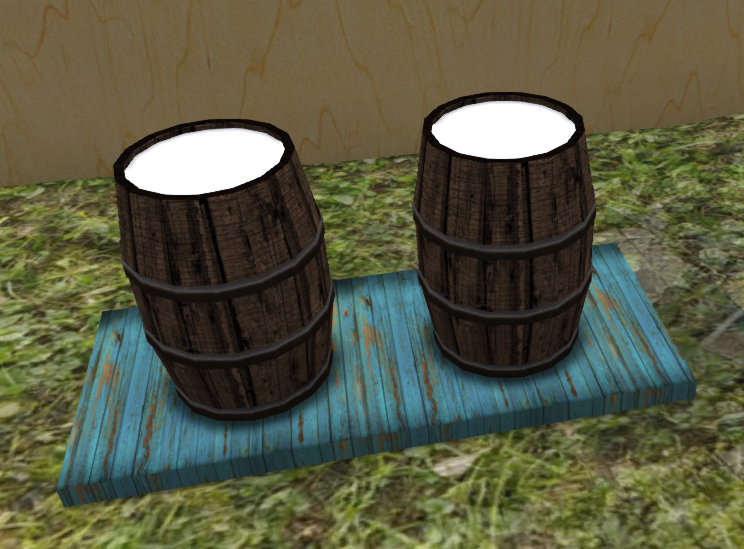
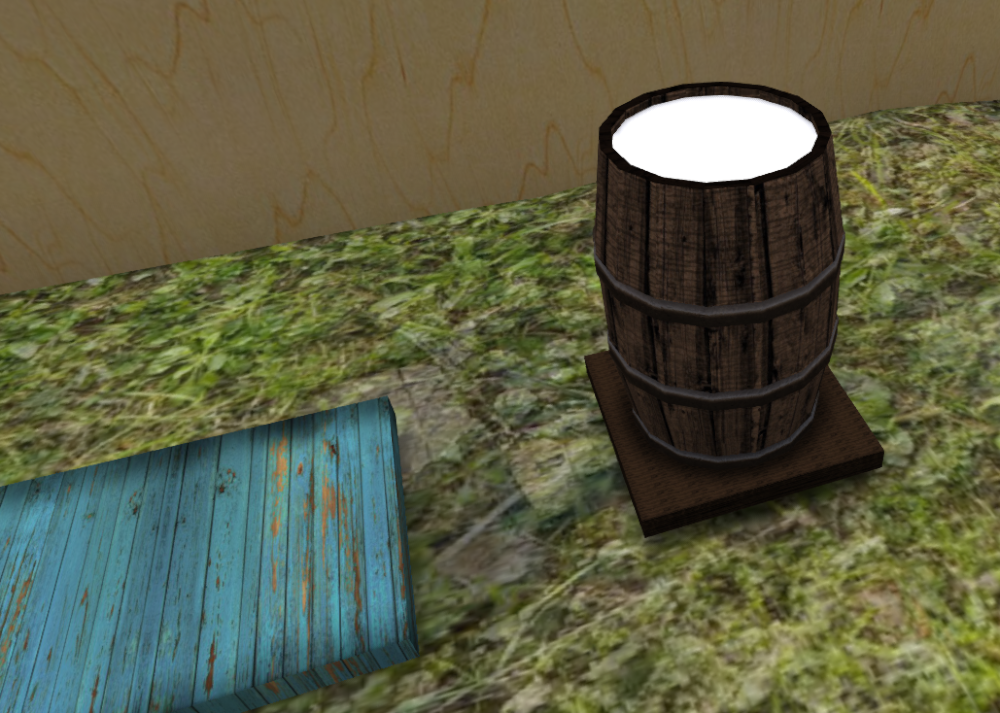
Agora, precisamos de adicionar um prim para servir de indicador para as pétalas de dente-de-leão e outro prim para as pétalas de gardénia. Para isso, vamos começar com um dos SF Store Barrels que tem um prim de nível de textura, mas pode usar qualquer prim que se adeqúe ao seu design.
Este barril de loja já tem todos os componentes de armazenamento no prim de base, mas como já temos uma base para usar, vamos desvincular esse prim do barril de loja. Como queremos indicadores para dois produtos, fazemos uma cópia do barril e posicionamos os dois barris sobre a nossa base de armazenamento.
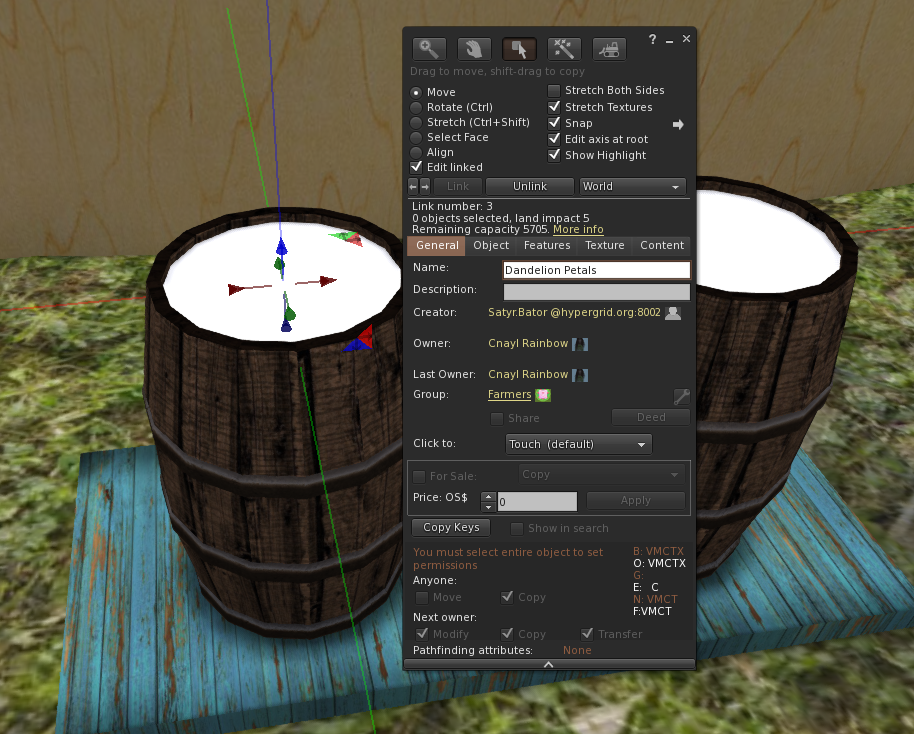
Em seguida, ligamos todos os componentes, certificando-nos de que a base é o último prim a ser ligado (por isso é o prim raiz)
Agora, precisamos de configurar os dois prims que vão ser os nossos indicadores de nível. Definimos o nome do prim que queremos utilizar como indicador de nível para corresponder ao nome do produto (menos a parte SF), por isso, neste exemplo, vamos definir um prim para se chamar Dandelion Petals (pétalas de dente-de-leão ) e o outro para Gardenia Petals (pétalas de gardénia).
Como sempre, tem de se certificar de que o nome e as letras maiúsculas e minúsculas correspondem exatamente ao produto - por exemplo, se dermos a um dos prims o nome de Dandelion Petals (pé talas de d ente-de-leão), não funcionará.
Agora, tudo o que precisamos de fazer é adicionar as SF Dandelion Petals e as SF Gardenia Petals ao conteúdo da nossa nova unidade de armazenamento. Assim que o fizeres, deves ver os indicadores de nível para ambos os produtos.
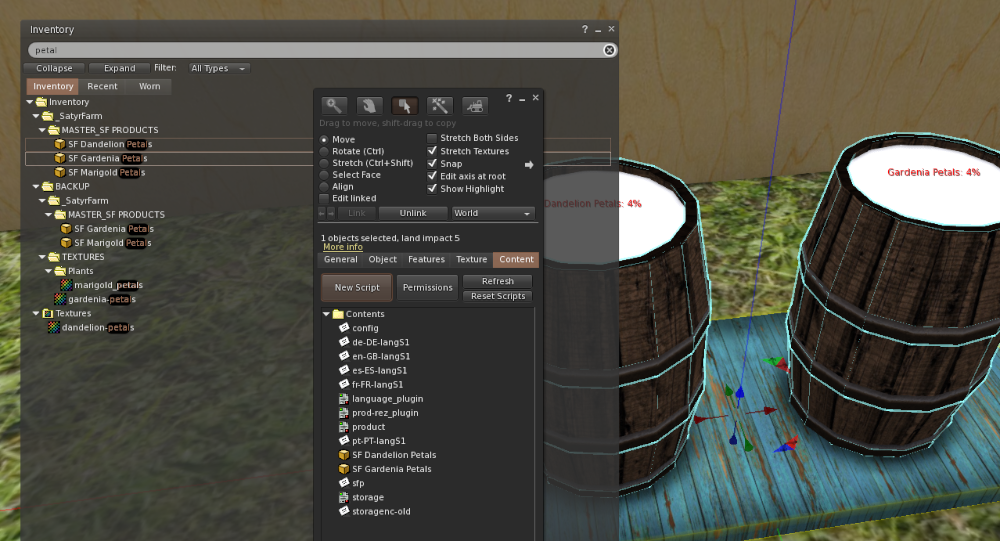
Podem então mudar as texturas do branco em branco para algo que corresponda ao vosso produto.
Se quisermos ir mais longe, podemos configurar esta unidade de armazenamento de modo a que os prims indicadores se movam para cima e para baixo para refletir os níveis reais dos produtos. Para isso, precisamos de calcular alguns números para colocar na descrição dos indicadores primários
Primeiro, tome nota da posição dos objectos - só precisamos do valor Z
I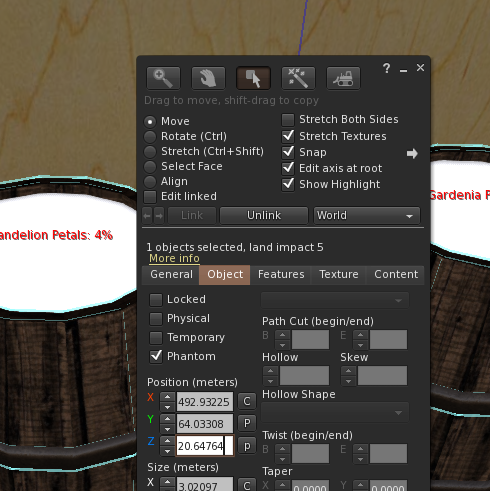 No nosso caso, é 20,64764
No nosso caso, é 20,64764
Em seguida, tomamos nota do valor Z do indicador para quando nos está a mostrar 0% e 100%
100% = 21.900
0% = 20.81450
Agora podemos calcular os valores necessários para a descrição da cartilha
20.81450 - 20.64764 = 0.16686
21.900 - 20.64764 = 1.25236
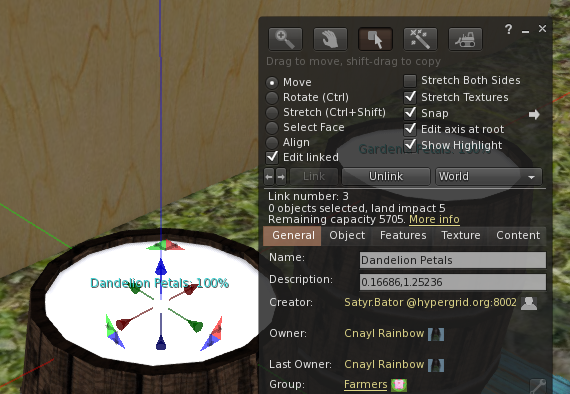
Portanto, agora só precisamos de definir a descrição da prim para 0.16686,1.25236
Como só estamos interessados no movimento Z, podemos utilizar os mesmos valores para ambas as prims.
Para verificar se tudo funciona, edita o bloco de notas de configuração e define primeiro o nível inicial para 100%
INITIAL_LEVEL=100
Guardem o notecard e reiniciem os scripts e deverão ver a indicação de 100%. Agora edita novamente o bloco de notas e, desta vez, define o nível para 0%
INITIAL_LEVEL=0
Agora, quando reiniciar, deverá obter a posição 0%.
Edite o bloco de notas de configuração para colocar o valor INITIAL_LEVEL no valor que pretende utilizar (a predefinição é 4) e está pronto para começar a armazenar coisas!
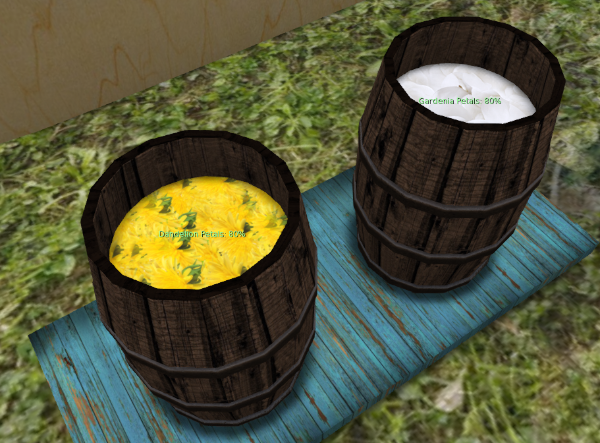
Dar um nome à sua loja
Pode mudar o nome do seu novo item de armazenamento para o que quiser, como SF Petal Store
Se pretender utilizar os produtos desta loja em conjunto com a opção AutoFeed nos alimentadores de animais, basta atualizar o cartão de notas de configuração para que estes tenham o mesmo nome configurado. Também poderá querer adicioná-lo ao notecard de actualizáveis se estiver a usar o SF Updater-Storage
Modo de partilha
Isto permite que outros itens, como a troca, acedam à unidade de armazenamento e façam uma cópia de qualquer item. Quando o fazem, não afectam o nível de armazenamento. É uma forma útil de, por exemplo, a bolsa poder alargar a gama de artigos que tem em oferta para incluir novos produtos.
Texto flutuante
Por defeito, uma loja mostra os níveis de todos os produtos que contém como uma lista de texto flutuante. Para as lojas que têm muitos artigos, isto pode tornar-se um pouco difícil de ler, pelo que pode querer adicionar prims ligados extra para ter texto flutuante sobre cada um deles, mostrando o estado dos produtos individuais. Por exemplo, para SF Olives, a prim ligada com o nome "Olives" é utilizada para mostrar o texto sobre o nível atual de SF Olives. Note que o prim raiz continuará a mostrar os níveis de quaisquer produtos armazenados que não tenham o seu próprio prim nomeado no conjunto de ligação.
Isto é puramente estético, uma vez que nada é armazenado nestas prims extra.
Definições do bloco de notas de configuração
Provavelmente, o principal item do bloco de notas de configuração que poderá ter de ajustar para a sua nova loja é o REZ_POSITION
# Qual o nível em que o armazenamento deve começar quando rezzed INITIAL_LEVEL=4 # # Quanto é retirado/adicionado na utilização ONE_PART=2 # # Quantos dias antes do nível cair 1 parte DROP_TIME=14 # # Qual é o máximo que esta loja pode conter (100 dá níveis de stock em %, maior que 100 dá níveis como e.g. 25/110 ) MAX_FILL=100 # # ASC para ordenação ascendente (A a Z) ou DEC para ordenação descendente (Z a A) SORTDIR=ASC # # Offset para rez item REZ_POSITION=<0.0, 0.0, 1.5> # # Até onde procurar itens SENSOR_DISTANCE=10 # # Partilha de produtos por região. Todos partilham com todos, Grupo apenas com o mesmo grupo, Nenhum sem partilha SHARE_MODE=All # # Definir como 1 para permitir que qualquer membro do grupo utilize o botão de menu 'Adicionar stock', 0 para permitir apenas o proprietário GROUP_STOCK_ADD=0 # # Cor do texto flutuante - definir como vetor de cor ou utilizar OFF para texto não flutuante TXT_COLOR=<1.0, 1.0, 1.0> # # # Brilho do texto 1 a 10 (10 é o brilho máximo) TXT_BRIGHT=10 # # # Idioma predefinido LANG=pt-GB # # # Altere isto se os seus produtos não começarem por 'SF' SF_PREFIX=SF
Para saber mais sobre o sistema de armazenamento, consulte o capítulo 14

Este trabalho de Buzzy Cnayl está licenciado sob umaLicença Creative Commons Atribuição-NãoComercial-CompartilhaIgual 4.0 Internacional.
Baseado num trabalho emhttps://satyrfarm.github.io/
- Detalhes
- Read Time: 8 mins
9.1 - Storage wells
We have used the SatyrFarm Well and also the SF Water tower – these are both examples of the ‘storage well’ system. Items in this system gradually fill up and store one specific product and as long as the level is greater than the ‘one part’ setting you can take some of the product. For the SatyrFarm well it was water but we also can get rennet from the SF Rennet Container, yeast from the SF Yeast Container and sea water from the SF Sea Water pump etc.
There are various configuration options to allow you to put some restrictions on the system by specifying how the item functions. For example you can set that it needs to be close to something in order for the level to increase. You can specify an actual item or set it that it needs to be at sea level – the SF Sea Water pump is an example of the latter. We can also specify what ‘energy’ drives it and we can specify wind (like the first water tower we used that require a wind pump near them), grid (like the example shown in the section on electricity for setting water towers to use the grid), or ‘self’ (such as the SatyrFarm well)
# Level to start at on rez/hard reset
INITIAL_LEVEL=10
#
# What liquid is this system for
LIQUID=Water
#
# How much to increase/decrease level by for one 'serving'
ONE_PART=2
#
# How many days before level drops 1 part ('evaporation')
DROP_TIME=2
#
# Offset to rez water buckets
REZ_POSITION=<1.0, 0.5, 0.0>
#
# Set to 0 to disable menu and just rez product on touch
MENU_MODE=0
#
# Set to 0 if you don't want to allow adding SF_WATER item via menu to top up level
ACCEPT_PRODUCT=0
#
# Can be WIND, GRID, SELF or RELAY which relates to using Wind powered water pump, Electric pump, built in system or via another nearby storage-well
MODE=RELAY
#
# In RELAY mode, where to get water from
RELAY_WELL=SF Water Tower
#
# Set to 1 for clouds, rain and other effects
WEATHER=1
#
# If WEATHER=1 set the range of the rain in m
RAIN_RADIUS=35
#
# How often in seconds to increase level by ONE_PART if MODE=SELF
WATERTIME=600
#
# SEA_LEVEL forces it to be at sea level to work. Can also specify item to scan for or remove/comment out if not needed
REQUIRES=SEA_LEVEL
#
# radius in m to scan for REQUIRES item
RANGE=6
#
# Default language
LANG=en-GB
(A) Examples of the various settings
LIQUID=
This is the item that is produced such as water, sea water, yeast etc. If this item is not in the contents as a product (e.g if LIQUID=Water the the product is SF Water) the system will check with storage locations to try and find a copy and if it is unable to find it then it will show on float text that it needs that item.
MENU_MODE=
If set to 1 then menu mode is enabled and touching the item will give you a menu. If set to 0 this disables the menu and touching immediately rezzes the product. If you are using the NPC Farmer then the item that it uses to fetch water must be set this way.
ACCEPT_PRODUCT=
If menu mode is active, you can enable or disable the option to allow you to top up the storage well via the ‘Add’ button
MODE=
The options are WIND which requires an SF Wind Pump nearby, GRID which allows it to take power from the electricity grid, RELAY which allows you to link wells together and SELF which means it does not require energy.
REQUIRES=
If you enter SEA_LEVEL then the Z height position should be near to the regions Water Height setting in order for it to operate.
You can also specify the name of something that needs to be close to the well for it to work. As an example you may decide that for producing yeast, the well needs to be close to the SatyrFarm Distillery so you would edit the notecard to have the line:
REQUIRES=SatyrFarm Distillery
If you do not require anything for operation, just remove or comment out the REQUIRES= line
WEATHER=
Setting this to 1 will enable anyweather or other special effects system. You can find more information on creating your own weather and effects systems in chapter 13.9
9.2 IRRIGATION
Plants, animals and mining all require water. There are various ways to get the water to where it is needed and you can use one or a combination of the following:
(A) Manual watering
You take water from any of the storage wells that are set to give water. As the SF Water is product, you can touch it and have it follow you as you go to the item that requires water. Don’t forget you can have more than one bucket follow you but don’t get to ambitious – 4 or 5 is probably a good maximum! You can also use one of the watering carts if you don’t fancy to much walking!
Manual water means you don’t need to have any storage wells near things but you do need to keep an eye on water levels, as if they get to low for to long plants and animals may die on you!
(B) NPC Farmer watering
The NPC farmer can be used to water plants and animal feeders. You need to ensure that there is a storage well within the farmers range that has menu mode disabled, since the farmer expects to just touch it to get the water.
NPC farmers visit items on a relatively random basis and only know if to water an item when they visit it, so if you have too many items for the NPC to manage it may miss items that are in desperate need of water!
(C) Auto watering
Anything that needs water has an ‘auto’ option. Turning this on means the item will look to automatically get water from the closest source. Check the config notecard to see if there is an option to set the source, if not then it will be looking for a storage well called SF Water Tower The limit for searching is a 96m radius. Note also that if the closest storage-well found is not in the same group as the thing requesting it, an error message is given. If you have plants, animal feeders etc. That are close to a neighbours water towers, you may see this error message and then need to either move your items or put a water source closer to them.
Generally the water level can get quite low before the plant, feeder etc. Calls for more water. If you have to many items trying to get water from the one storage well then it’s possible the well may not be able to fill up quickly enough to meet the demand, and so you should keep an eye on how much things use.
As we have seen there are various ways to configure these water towers:
Wind mode
The ‘SF Wind Pump’ will start gradually filling with water after it is first rezzed and when it gets to 100% (about 2 hours from a fresh rez) it sends one portion of water to the closest item called “SF Water Tower” (note though that the maximum distance between the two can be no more than 96m) The wind pump will now continue to send one portion at regular intervals (approx 15-20 minutes)
If the demand on the water tower is too high it may run out of water before the next load is sent from the pump. A wind pump can only supply one water tower.
Grid mode
When the water level in a grid mode storage-well drops below about 40% it will send a request to the regional (electric) water pump for more water. The pump first checks there is enough power in the grid and if so will start and send water to the requesting storage-well.
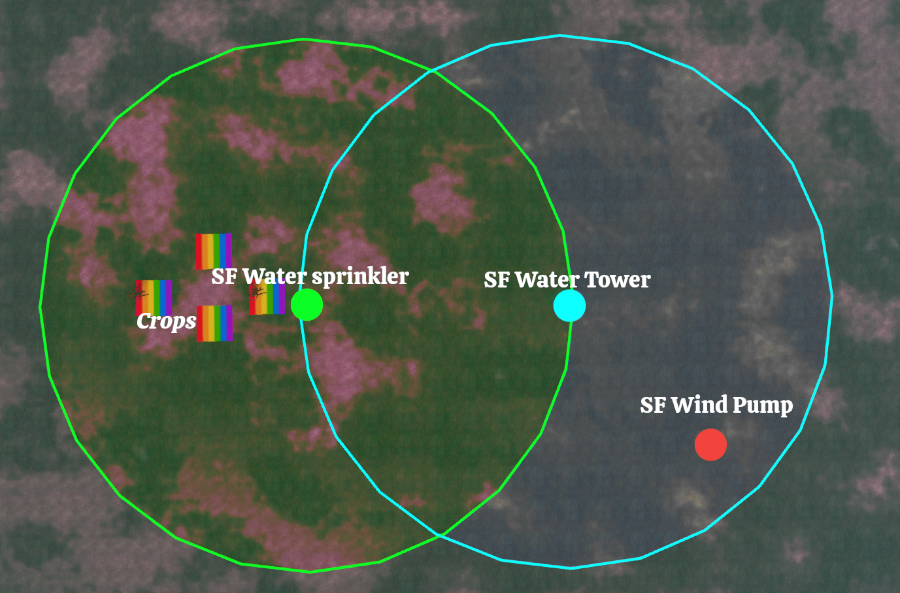
Relay mode
In relay mode you can set one storage well to get water from another storage well. As an example you could put out some SF Water sprinklers near your plants and set the plants to get their water from the sprinklers. Then you set the sprinklers to get their water from the SF Water Tower.
The blue circle shows the range of the main water tower and the green circle is the range of the water sprinkler. You could add more sprinklers anywhere in the blue circle to extend the range even further.

This work by Cnayl Rainbow is licensed under a Creative Commons Attribution-NonCommercial-ShareAlike 4.0 International License.
Based on a work at https://satyrfarm.github.io/
- Detalhes
- Read Time: 1 min
2.4 - Getting assistance
(a) The NPC Farmer
Perhaps you would like a ‘farm hand’ to help with odd jobs around the farm?
The pillar next to the water tower is the control system for an NPC Farmer (NPC means ‘non-player character’ see http://opensimulator.org/wiki/OSSLNPC)
We can have an NPC Farmer help us with some basic chores.
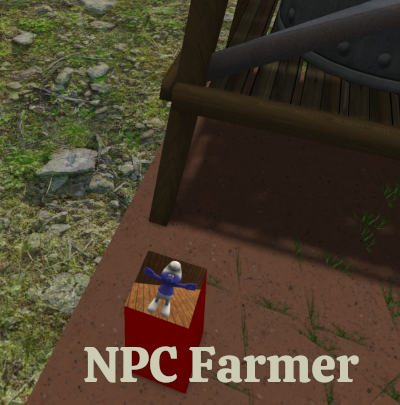
How does the Farmer NPC Work?
The Farmer NPC is constantly looking for farm items within range (set via the config notecard which we will cover soon). It will try to get water and then water plants with less than 30% water. The farmer will harvest plants and put their harvest in the configured storage location.
The farmer can also be set to cook slop and then store that away also. So the NPC Farmer can completely sustain a small farm, assuming that non-grass animal feeders have AutoFood set to on.
Troubleshooting
When rezzing an NPC , it should appear right in front of the rezzer box. If they are rezzed at the edge of the sim instead, this means you have closed access to your parcel. This will cause the NPC to fail. Please allow access to the parcel - the NPC will use the group of the controller and make sure age restriction is off.
If the farmer rezzes okay but just stands still, this is normally because the NPC rezzer box is set to a different group to the parcel. Click the rezzer to remove the NPC then change so that both land and rezzer are in same group. You should now find that the farmer sets off to the well as soon as it appears.
All currently available NPC Farmers

This work by Buzzy Cnayl is licensed under a Creative Commons Attribution-NonCommercial-ShareAlike 4.0 International License.
Based on a work at https://satyrfarm.github.io/
- Detalhes
- Read Time: 5 mins
2.1 Setting Up OpenSim
(a) Opensim - Versions and configuration
The VivoSim system has been built and tested to work on the official release versions of opensim 0.9.0.1 onwards. It supports both XEngine and YEngine. Anything that uses physics will have a note to tell you if it is designed for one particular type or can auto-sense the physics engine.
Please note that if you use builds other than that from opensimulator.org things may or may not work as I can't test every version, unfortunately!
(b) Setting Standard Permissions
Before using (or even rezing) any parts of this system in your region, you should ensure that you have the correct permissions for the required OSSL functions by editing the settings in the osslEnable.ini file (in bin/config-include folder) If you do not have access to this file you will need to get your region host to change them for you. Note that in newer versions of OpenSimulator you may need to copy osslEnable.ini.example to osslEnable.ini
[NOTE: in opensim ini files the ; symbol at the start of a line turns it into a comment. In the following, we comment out the first two lines and uncomment the next two]
osslParcelO = "" osslParcelOG = "" ;osslParcelO = "PARCEL_OWNER," ;osslParcelOG = "PARCEL_GROUP_MEMBER,PARCEL_OWNER,"
; osslParcelO = "" ; osslParcelOG = "" osslParcelO = "PARCEL_OWNER," osslParcelOG = "PARCEL_GROUP_MEMBER,PARCEL_OWNER,"
Then add/edit the various function levels to:
; ThreatLevel VeryLow
Allow_osSetDynamicTextureDataBlendFace = ${OSSL|osslParcelOG}ESTATE_MANAGER,ESTATE_OWNER
; ThreatLevel Low
Allow_osMessageObject = ${OSSL|osslParcelOG}ESTATE_MANAGER,ESTATE_OWNER
; ThreatLevel High
Allow_osMakeNotecard = ${OSSL|osslParcelOG}ESTATE_MANAGER,ESTATE_OWNER
; ThreatLevel VeryHigh
Allow_osGetNotecard = ${OSSL|osslParcelOG}ESTATE_MANAGER,ESTATE_OWNERNext, to make sure everything works as it should, change your active group to match that of the parcel that your farm is in. You should make sure all farm items are set to that group.
(c) Setting Permissions for NPC Farmer
If you plan to use any NPC Farmers then the following additional setting is required:
; ThreatLevel Moderate
Allow_osSetSpeed=ESTATE_MANAGER,ESTATE_OWNER,PARCEL_OWNERAlso edit your OpenSim.ini
[NPC]
Enabled = true(d) Setting Permissions for fishing system
If you plan to use the fishing system then the following additional setting is required:
; ThreatLevel VeryHigh
Allow_osForceDetachFromAvatar=ESTATE_MANAGER,ESTATE_OWNER,PARCEL_OWNER(e) Setting Permissions for VivoSim Exchange
If you plan to put out any exchange boxes then the following additional settings are required:
; ThreatLevel Moderate
Allow_osGetGridLoginURI=${OSSL|osslParcelO}ESTATE_MANAGER,ESTATE_OWNER(f) Setting Permissions for Rental system
The default ossl settings will allow the estate owner and managers as well as the parcel owner to use the rental system. If you are getting errors, or you wish to also allow group members to use it, you should set/edit the following:
; ThreatLevel Moderate
Allow_osGetGridHomeURI=${OSSL|osslParcelOG}ESTATE_MANAGER,ESTATE_OWNER(g) Dealing with errors
If you are getting permission errors make sure the above permissions are correctly set. You can get an OSSL Tester box at the VivoSim store on Mintor - rez this and it will check things are set up okay.
Next, to make sure everything works as it should, change your active group to match that of the parcel that you will rez the platform in. Anyone that is a member of that group will be able to interact with the farm. That group should have Object Entry and Run Scripts permissions.
If you have any problems setting the above up,
please do use the VivoSim forums to get assistance.
(h) Selecting languages
This guide and the default settings for all items is to use UK English, however, you can change the language items used from the @ button on menus. You can also edit the config notecard to set the default language.
If your preferred language is not shown please do let me know and I will look into adding it.
We are also grateful if anyone wishes to translate this guide into other languages (see https://translate.vivosim.net)

This work by Buzzy Cnayl is licensed under a Creative Commons Attribution-NonCommercial-ShareAlike 4.0 International License.
Based on a work at https://satyrfarm.github.io/
- Detalhes
- Read Time: 4 mins
These are the default settings for all animals. For all animals touching them and selecting Info from the menu will tell you all about them. You can edit the an_config notecard in animals to change what they eat from and more.
| Animal | Lifespan (~days) | Feeder | Milk/Eggs | Wool | Manure | Death items |
| Bantha | 200 | SF Feeder | SF Wool | ✓ | SF Meat, SF Skin | |
| Black Bear | 250 | SF Feeder | ✓ | SF Meat, SF Skin | ||
| Boar | 90 | SF Hog Feeder | ✓ | SF Meat, SF Skin | ||
| Bosk | 150 | SF Feeder | SF Bosk Milk | SF Wool | ✓ | SF Meat, SF Skin |
| Brachiosarus | 200 | SF Feeder | ✓ | SF Meat, SF Skin | ||
| Buffalo | 180 | SF Feeder | SF Milk | ✓ | SF Meat, SF Skin | |
| Bulldog | 200 | SF Dog Feeder | SF RIP | |||
| Camel | 100 | SF Feeder | SF Wool | ✓ | SF Meat, SF Skin | |
| Cat | 200 | SF Cat Feeder | SF RIP | |||
| Cow | 40 | SF Feeder | SF Milk | ✓ | SF Beef, SF Skin | |
| Crocodile | 200 | SF Tiger Feeder | SF Meat, SF Skin | |||
| Dolphin | 100 | SF Fish Feeder | SF Fish | |||
| Donkey | 50 | SF Feeder | ✓ | SF Meat, SF Skin | ||
| Duck | 30 | SF Chicken Feeder | SF Duck Egg | SF Feathers | SF Duck Meat | |
| Elephant | 200 | SF Feeder | ✓ | SF Meat, SF Skin | ||
| Elk | 60 | SF Feeder | ✓ | SF Meat, SF Skin | ||
| Farm Chicken | 30 | SF Chicken Feeder | SF Eggs | SF Feathers | ✓ | SF Chicken |
| Fox | 90 | SF Dog Feeder | SF Meat, SF Skin | |||
| Gem Dolphin | 120 | SF Fish Feeder | SF Fish | |||
| Giraffe | 200 | SF Feeder | ✓ | SF Meat, SF Skin | ||
| Goat | 40 | SF Feeder | SF Milk | SF Wool | ✓ | SF Meat, SF Skin |
| Great Dane | 200 | SF Dog Feeder | SF RIP | |||
| Hog | 90 | SF Hog Feeder | ✓ | SF Pork, SF Skin | ||
| Horse | 200 | SF Feeder | ✓ | SF Meat, SF Skin | ||
| Husky | 200 | SF Dog Feeder | SF RIP | |||
| Labrador | 200 | SF Dog Feeder | SF RIP | |||
| Leopard | 100 | SF Tiger Feeder | SF Meat, SF Skin | |||
| Lion | 150 | SF Tiger Feeder | ✓ | SF Meat, SF Skin | ||
| Llama | 100 | SF Feeder | SF Milk | SF Wool | ✓ | SF Meat, SF Skin |
| Monkey | 300 | SF Feeder | ✓ | SF RIP | ||
| Living Rock | 300 | SF Rock Feeder | SF Mineral | SF Clay, SF Rock Skin | ||
| Monster | 200 | SF Tiger Feeder | ✓ | SF Meat, SF Skin | ||
| Ostrich | 300 | SF Chicken Feeder | SF Ostrich Egg | SF Feathers | ✓ | SF Ostrich Meat, SF Feathers |
| Panda | 200 | SF Feeder | ✓ | SF RIP | ||
| Penguin | 100 | SF Fish Feeder | ✓ | SF Meat, SF Skin | ||
| Pet Rock* | 300 | SF Rock Feeder | SF Mineral | SF Clay, SF Rock Skin | ||
| Pig | 30 | SF Pig Feeder | ✓ | SF Pork, SF Skin | ||
| Polar Bear | 250 | SF Fish Feeder | ✓ | SF Meat, SF Skin | ||
| Rabbit | 30 | SF Rabbit Feeder | SF Meat, SF Skin | |||
| Rainbow Trout | 10 | SF Fish Feeder | SF Trout | |||
| Raptor | 100 | SF Tiger Feeder | ✓ | SF Meat, SF Skin | ||
| Reindeer | 60 | SF Feeder | ✓ | SF Meat, SF Skin | ||
| Rhino | 200 | SF Feeder | ✓ | SF Meat, SF Skin | ||
| Sheep | 40 | SF Feeder | SF Milk | SF Wool | ✓ | SF Lamb, SF Skin |
| Squid | 10 | SF Fish Feeder | SF Calamari | |||
| Squirrel | 200 | SF Chicken Feeder | ✓ | SF Meat, SF Skin | ||
| Stegosaurus | 200 | SF Feeder | ✓ | SF Meat, SF Skin | ||
| Swan | 200 | SF Chicken Feeder | SF Feathers | SF Swan Meat | ||
| T.Rex | 200 | SF Tiger Feeder | ✓ | SF Meat, SF Skin | ||
| Tauntaun | 200 | SF Feeder | SF Wool | ✓ | SF Meat | |
| Tiger | 100 | SF Tiger Feeder | SF Meat, SF Skin | |||
| Triceratops | 200 | SF Feeder | ✓ | SF Meat, SF Skin | ||
| Tuna Fish | 10 | SF Fish Feeder | SF Tuna | |||
| Turkey | 30 | SF Chicken Feeder | SF Feathers | SF Turkey Meat | ||
| Turtle | 150 | SF Feeder | SF RIP | |||
| Unicorn | 300 | SF Feeder | SF Horn | ✓ | SF Meat, SF Skin | |
| Water Buffalo | 120 | SF Feeder | SF Milk | ✓ | SF Meat, SF Skin | |
| White Rhino | 200 | SF Feeder | ✓ | SF Meat, SF Skin | ||
| Zebra | 200 | SF Feeder | ✓ | SF Meat, SF Skin |
* Pet Rock renamed to Living Rock from version 5.9 onwards

This work by Buzzy Cnayl is licensed under a Creative Commons Attribution-NonCommercial-ShareAlike 4.0 International License.
Based on a work at https://satyrfarm.github.io/
- Detalhes
- Read Time: 1 min
These are the default settings for all animals. For all animals touching them and selecting Info from the menu will tell you all about them. You can edit the an_config notecard in animals to change what they eat from and more.
| Animal | Lifespan (~days) | Feeder | Milk/Eggs | Wool | Manure | Death items |
| SF Black Larl | 150 | SF Larl Feeder | ✓ | SF Sable Pelt | ||
| SF Bosk | 30 | SF Feeder | SF Bosk Milk | SF Skin & SF Bosk Meat | ||
| SF Bounding Hurt | 200 | SF Feeder | SF Raw Hurt Wool | ✓ | SF Meat | |
| SF Farm Vulo | 30 | SF Bird Feeder | SF Eggs | ✓ | SF Vulo Meat | |
| SF Giani | 30 | SF Giani Feeder | SF RIP | |||
| SF Giant Tarsk | 90 | SF Tarsk Feeder | ✓ | SF Skin & SF Tarsk Meat | ||
| SF Jungle Larl | 30 | SF Larl Feeder | ✓ | SF Jungle Pelt | ||
| SF Saru | 200 | SF Veg Feeder | ✓ | SF RIP | ||
| SF Sleen | 30 | SF Sleen Feeder | SF Raw Wool | ✓ | SF Skin & SF Meat | |
| SF Snow Larl | 30 | SF Larl Feeder | ✓ | SF Snow Pelt | ||
| SF Snow Lart | 90 | SF Lart Feeder | SF Lart Pelt & SF Meat | |||
| SF Squirrel | 200 | SF Bird Feeder | ✓ | |||
| SF Tabuk North | 60 | SF Feeder | ✓ | SF Tabuk Meat | ||
| SF Tabuk Prairie | 60 | SF Feeder | ✓ | SF Tabuk Meat | ||
| SF Tarsk | 90 | SF Tarsk Feeder | ✓ | SF Skin & SF Tarsk Meat | ||
| SF Tawny Red Larl | 30 | SF Larl Feeder | ✓ | SF Tawny Red Pelt | ||
| SF Tharlarion | 30 | SF Tharl Feeder | ✓ | |||
| SF Tumit | 200 | SF Bird Feeder | SF Tumit Egg | ✓ | SF Skin & SF Tumit Meat | |
| SF Turtle | 30 | SF Veg Feeder | SF RIP | |||
| SF Verr | 40 | SF Feeder | SF Verr Milk | SF Raw Wool | ✓ | SF Verr Meat |

This work by Buzzy Cnayl is licensed under a Creative Commons Attribution-NonCommercial-ShareAlike 4.0 International License.
Based on a work at https://satyrfarm.github.io/
- Detalhes
- Read Time: 6 mins
Starter Kit – Basics
This platform contains everything you need to get started using VivoSim. If you are new to the system it is recommended to first get this box and rez the platform, then follow the tutorial at /information/user-guide
Once you have grasped the basics, you can then choose to expand if you wish using the various options in the other expansion packs.
Contents
SF Wind Pump
SF Water Tower
SatyrFarm Well
SF Feeder
SF Pig Feeder
SF Small Field
SF Square Field
SF Basic Storage
SatyrFarm Kitchen
SF NPC Controller
Pack 1 – Plants & Trees
In addition to the two fields found in the starter kit, this box contains additional plants and trees as well as two irrigation systems.
Contents
SF Big Tree
SF Maple Tree
SF Maple
SF Fig Tree
SF Olive Tree
SF Elder Tree
SF Oak tree
SF Horse Chestnut Tree
SF Walnut Tree
SF Coconut Palm
SF Flower Planter
SF Planter
SF Vine
SF Bramble
SF Marsh Field
SF Fungus
SF Wild Flowers
SF Physic Garden
SF English Herb Garden
SF Mediterranean Herb Garden
SF Fibre Crops
SF Water sprinkler
SF Water Tower (clouds and rain effect)
Pack 2 – Storage
Once you start expanding with new crops, animals, crafting etc, you will find the required additional storage systems here.
Contents
SF Storage Rack
SF Kitchen Storage
SF Fridge
SF Freezer
SF Spice Storage
SF Cake Storage
SF Bread Storage
SF Maple Syrup Store
SF Milk Storage
SF Meat Store
SF Dried Goods Store
SF Fresh Herb Storage
SF Herb Bench
SF Barrels Storage
SF Herbalist
SF Coldframe
SF Pet Supplies
SF Wood Storage
SF Wood Basket
SF Utility Storage
SF Craft Store
SF Crafting Storage
SF Clay Storage
SF Bulk Storage (juice)
SF Bulk Storage (slop & fish)
Bulk Milk Storage
SF Fuel Storage
SF Manure Storage
SF HaystackSF Vase
SF Store Barrel (yarn)
SF Store Barrel (wool)
SF Candle Storage
SF Keg Store
SF Barrel Store
SF Vase
SF Sea Water pump
SF Yeast Container
SF Rennet Container
Pack 3 – Animal extras
Once you start adding animals other than those used in the tutorial, you will need to have feeders specific to the animals needs. These are found in this pack. There is also a fishing system, bee hive and chicken coop. You can find out what feeder each animal feeds from using the ‘Information’ item on the animals menu or from the information at https://vivosim.net/help/animals
Contents
SF Feeder
SF Hog Feeder
SF Rabbit Feeder
SF Chicken Feeder
SF Tiger Feeder
SF Fish Feeder
SF Dog Feeder
SF Cat Feeder
SF Rock Feeder
SF Chicken Coop (standard and low prim version)
SF Beehive
SF Fishing
SF Fish Barrel
Pack 4 – Crafting
The items in this pack allow you to use the various products produced by plants, animals etc to make new items.
Contents
SF Crafting Workbench (2 styles)
SF Carpenter Workbench
SF Leatherwork
SatyrFarm Drier
SatyrFarm Loom
SF Spinning Wheel
SF Potters Wheel
SF Sewing Machine
SatyrFarm Extractor
SF Press
SF Shop (2 styles)
SF Smithy
SF Kiln
SatyrFarm Vat
Pack 5 – Eco converting
Converters take one ‘waste’ item and turn it into something useful!
Contents
SatyrFarm Compost
SF Quethane Generator
SF Privy (2 styles)
SF WC
SF Urinal
SF Potty (3 styles)
SF Toilet Roll Holder (2 styles)
SF Bookcase (2 styles)
Pack 6 – Food & Drink
If you have decided to use the HUD then food and drink are needed to keep you well!
Contents
SatyrFarm Wood Oven
SF Kitchen Oven
Extractor hood
SF Frying Pan
SF Hob
SF Sink
SF Salad Bar
SF Toaster
SatyrFarm Grinder
SF Hot Drinks Maker
SF Drinks maker (Soft drinks)
SF Drinks maker (Bar)
SF Blender
SF Ice Creams
SF Drying Rack
SatyrFarm Juicer (2 styles)
SF Cheese Maker (2 styles)
SF Butter Churn
SF Microbrewery
SatyrFarm Distillery
SF Wine Maker
SF Table
SF Seat (x4)
Pack 7 – Household
Although SatyrFarm started out as a farm, VivoSim extends into your house, turning it into a home.
Contents
SF Chair
SF Wardrobe
SF Wood Stove
SF Firepit
SF Shower (PMAC)
SF Dresser
SF Jewellery Box (2 styles)
SF Sink
SF Soap Dish
SF Bathroom Storage
SF Towel Rail
SF Bathtub
SF Bed (2 styles plus ‘bed prim’)
MLP Addon kit
PMAC Addon kit
Sit/Poseball Addon kit
Pack 8 – Region Power
You can use the items in this pack to set up a region wide power system.
Contents
SF Eco Generator – Water
SF Solar Panel
SF Wind Turbine (2 styles)
SF Water Tower (shiny style)
SF Electric Pump
SF Power controller
SF Generator
SF Charger
SF Electric Streetlight
SF Battery Storage
SF Treadmill
SF Electrical Addons
Pack 9 – Mining
You can mine and also grow various rocks and minerals with the items in this pack.
Contents
SF Mine
SF Pump Jack
SF Mineral Store
SF Gems (2 styles)
SF Gem Storage
SF NPC Controller (configured for SF Gems)
Pack 10 – Forestry
This pack adds new trees that are used to create woods/forests for growing and working withwood in its many forms.
Contents
SF Pine Forest
SF Maple Tree (doesn’t produce maple sap)
SF Small Maple Tree (doesn’t produce maple sap)
SF Birch Clump
SF Birch Tree
SF Larch Tree
SF Autumn Tree
SF Elm Tree
SF Shade Tree
SF Forest Store
SF Wood Seasoning
Contents - Extras
SF Saw Mill (updated version of that found in pack 11)
SF Leaf Composter
SF Campfire
SF Firepit (updated version of that found in pack 7)
SF Wood Stove (updated version of that found in pack 7)
SF Firewood Store
Pack 11 – Large items
As the name suggests, various large items can be found here. Make sure to rez the platform somewhere with lots of room.
Contents
Red Barn
SF Silo Storage (3 styles)
SF Windmill
SF Saw Mill
SF Oast House
SF Shop (2 styles)
Box 12 – VivoSim Exchange
The VivoSim Exchange lets you buy and sell items.
VivoSim HUD Box
Contains the VivoSim HUD along with other wearable items.
Contents
Main-HUD
Status-HUD
SF Pitchfork
Animal Rezzer Box
NOTE - The contents of this box are also found in the starter kit. You only need a copy of this if you already have the rezzer and a new version is released and you don't want another starter kit!
Contains the animal rezzer/updater and petifier.
Contents
Animal Rezzer
Petifier HUD

This work by Buzzy Cnayl is licensed under a Creative Commons Attribution-NonCommercial-ShareAlike 4.0 International License.
Based on a work at https://satyrfarm.github.io/
- Detalhes
- Read Time: 11 mins
Capítulo 2 - Comece aqui
2.1 Configurando
(A) Opensim - Versões e configuração
A edição Quintonia do SatyrFarm foi construída e testada para funcionar nas versões do opensim 0.9.0.1 em diante. Suporta XEngine e YEngine. Qualquer coisa que use física terá uma nota para lhe dizer se foi projetado para um tipo específico ou pode detectar automaticamente o mecanismo de física.
(B) Definir permissões
Antes de usar (ou mesmo rezing) qualquer parte deste sistema em sua região, você deve certificar-se de que possui as permissões corretas para as funções OSSL necessárias. Dependendo de quem você deseja poder usar sua fazenda, escolha uma das opções abaixo e edite as configurações, que podem ser encontradas em config-include / osslEnable.ini. Se você não tiver acesso a este arquivo, você precisará obter seu host sim para mudá-los para você. Você também deve ter habilitado NPCs em sua região (Set Enabled = true na seção [NPC] de seu arquivo OpenSim.ini)
Permitir que qualquer pessoa do mesmo grupo do lote, além de administradores
Allow_osMakeNotecard = ${OSSL|osslParcelOG}ESTATE_MANAGER,ESTATE_OWNER
Allow_osGetNotecard = ${OSSL|osslParcelOG}ESTATE_MANAGER,ESTATE_OWNER
Allow_osMessageObject = ${OSSL|osslParcelOG}ESTATE_MANAGER,ESTATE_OWNER
Allow_osSetDynamicTextureDataBlendFace = ${OSSL|osslParcelOG}ESTATE_MANAGER,ESTATE_OWNERPermitir apenas o proprietário do lote, além dos gerentes de propriedade
Allow_osMakeNotecard = ${OSSL|osslParcelO}ESTATE_MANAGER,ESTATE_OWNER
Allow_osGetNotecard = ${OSSL|osslParcelO}ESTATE_MANAGER,ESTATE_OWNER
Allow_osMessageObject = ${OSSL|osslParcelO}ESTATE_MANAGER,ESTATE_OWNER
Allow_osSetDynamicTextureDataBlendFace = ${OSSL|osslParcelO}ESTATE_MANAGER,ESTATE_OWNER
Permitir apenas o proprietário do lote
Allow_osMakeNotecard = ${OSSL|osslParcelOG}
Allow_osGetNotecard = ${OSSL|osslParcelOG}
Allow_osMessageObject = ${OSSL|osslParcelOG}
Allow_osSetDynamicTextureDataBlendFace = ${OSSL|osslParcelOG}
Se você estiver recebendo erros de permissão, certifique-se de que as permissões acima estejam definidas corretamente. Você pode obter uma caixa de OSSL Tester na loja Farm em Mintorrez e ele verificará se as coisas estão configuradas corretamente.
Se você tiver qualquer problema com a configuração acima, use os fóruns da Quintonia ou o servidor Discord para obter assistência.
Você pode obter uma caixa de testador de OSSL na loja Farm em Mintor - rez isso e ele verificará se as coisas estão configuradas corretamente.
A seguir, para ter certeza de que tudo funciona como deveria, mude seu grupo ativo para coincidir com o da parcela em que você rez a plataforma. Qualquer um que seja membro desse grupo poderá interagir com a fazenda. Se você deseja permitir que qualquer pessoa use o farm, você pode remover o grupo, ou seja, definir como ‘nenhum’.
(C) Seleção de idiomas
Este guia e as configurações padrão para todos os itens devem usar o inglês do Reino Unido; no entanto, você pode alterar o idioma usado pelos itens a partir do botão @ nos menus. Se o seu idioma preferido não for mostrado, talvez você possa nos ajudar adicionando à lista em https://translate.quintonia.net
Agradecemos também se alguém desejar traduzir este guia para outros idiomas.
2.2 Começando
(A) Rez a primeira plataforma
Ok, então agora estamos prontos para fazer o rez da plataforma 1 (encontrado na caixa 1) Todas as plataformas mostram qual o tamanho que eles terão quando você fizer o rez, então encontre um espaço adequado para a plataforma 1 (isso é tudo que estaremos fazendo para começar )
Uma boa ideia pode ser pressionar CTRL 3 primeiro, que ativa a ferramenta Editar de construção, de forma que quando você rez a plataforma tudo será selecionado e você pode reposicioná-la facilmente se necessário.
Esta plataforma contém tudo que você precisa para começar e começar a aprender como as coisas funcionam.

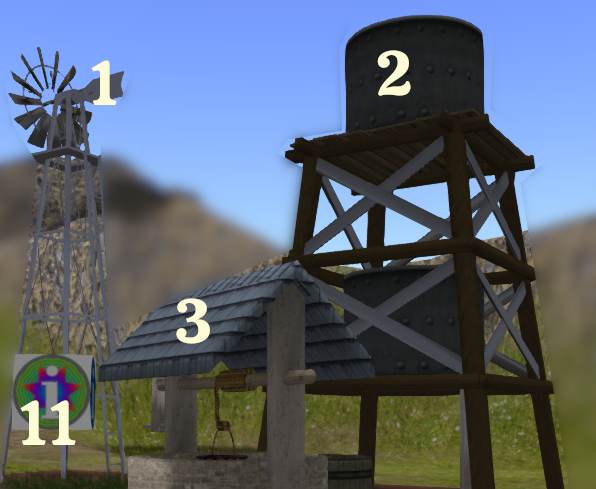
1 SF Wind Pump
2 SF Water Tower
3 SatyrFarm Well
4 SF Square Field
5 SF Small Field
6 SF Feeder
7 SF Basic Storage
8 SatyrFarm Kitchen
9 SF Pig Feeder
10 SF NPC-Farmer Controller
11 Caixa de informações
(B) Prepare-se para seus primeiros animais
Uma fazenda básica precisa apenas de um SatyrFarm Well e do SF Feeder e então está quase pronta para certos animais (ou seja, aqueles que podem comer grama). Antes de adicionarmos nossos primeiros animais, você pode notar que os alimentadores de grama estão mostrando "BEBA A ÁGUA BAIXA!", então precisamos completá-los. Para fazer isso, toque / clique com o botão esquerdo no poço e você verá um balde de água aparecer.
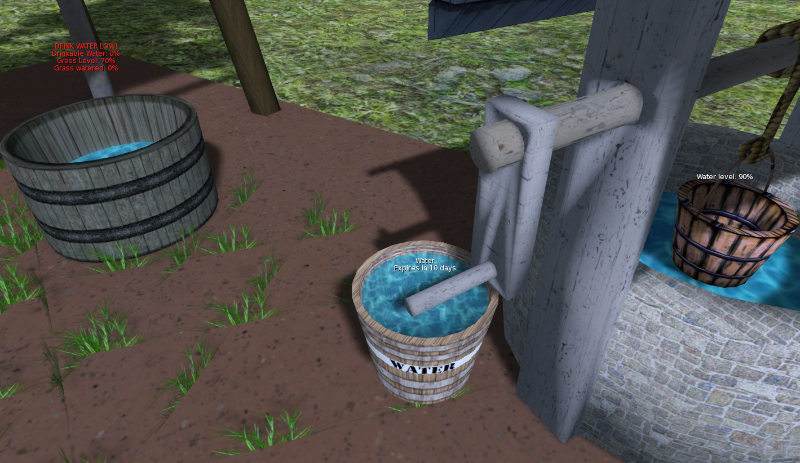
Se você tocar no balde, ele se moverá em sua direção e o seguirá conforme você andar. Então vá até que você esteja próximo a um dos barris de alimentação com o balde de água também perto dele. Toque no alimentador e você verá um menu com várias opções. Por enquanto, basta clicar no botão marcado como + água . A água escoará do balde para o alimentador e você verá os níveis aumentarem e agora diz que a grama precisa ser regada.
Pegue outro balde do poço e, desta vez, ao tocar no alimentador do menu, selecioneGramma d'água e depois de alguns segundos, você deve ter um pouco de grama exuberante e nenhum texto de aviso vermelho sobre o alimentador. Você também pode notar que o poço está mostrando o nível de 80% - cada vez que pegamos um balde de água, o nível cai e, em seguida, enche lentamente de volta com o tempo.
Quando adicionarmos animais, eles beberão a água do comedouro, além de comerem a grama, portanto, caberá a você continuar enchendo a água. Conforme sua fazenda cresce, isso pode começar a tomar muito do seu tempo, então há uma maneira de tornar a vida mais simples!
Tenho certeza que você notou a bomba de vento e a torre de água? A bomba de vento retira água do solo e a alimenta na torre de água mais próxima. A torre de água pode então ser usada para fornecer água automaticamente para as coisas que precisam (no momento, apenas nosso alimentador).
Se você tocar no segundo alimentador de grama para obter o menu, verá um botão marcado com + AutoWater . Se você clicar aqui, ele ativará o recurso de irrigação automática e o alimentador tentará encontrar uma torre de água dentro alcance (cerca de 90m de raio) Assim que encontrar a torre de água, você verá que ela se enche automaticamente. Contanto que haja água suficiente na torre de água, seu alimentador agora nunca mais precisará que você adicione água a ela - torna a vida mais fácil para você, não é mesmo! Você pode querer selecionar essa opção para o primeiro alimentador.
Conforme sua fazenda cresce, você pode precisar adicionar mais torres de água, mas vamos cobrir isso com mais detalhes mais tarde, pois por enquanto, deve haver bastante água disponível.
(C) Adicione seus primeiros animais
Em seu inventário, abra a pasta da Plataforma 1 e você verá um item chamado SF Animal Rezzer - Quintonia-V5.0
Você pode rezá-lo até o chão ou optar por usá-lo (será usado como um HUD), o que preferir.
O rezzer animal é de onde os animais vêm inicialmente. Também é usado para atualizar animais quando novos scripts atualizados são lançados.
Se você o tiver rezzado, mova-o para onde deseja que seu animal apareça (de preferência próximo a um dos comedouros de grama). Se você o estiver usando como um HUD, o animal será colocado a seus pés, então fique onde deseja que o animal apareça.
Toque na caixa HUD / para obter o menu e selecione o botão Rez ... . Há muitos animais para escolher, mas apenas alguns comem grama, então vamos começar com eles. Vamos começar com uma vaca. Quando você o rez, espere alguns segundos para inicializar e então você verá uma vaca feliz!
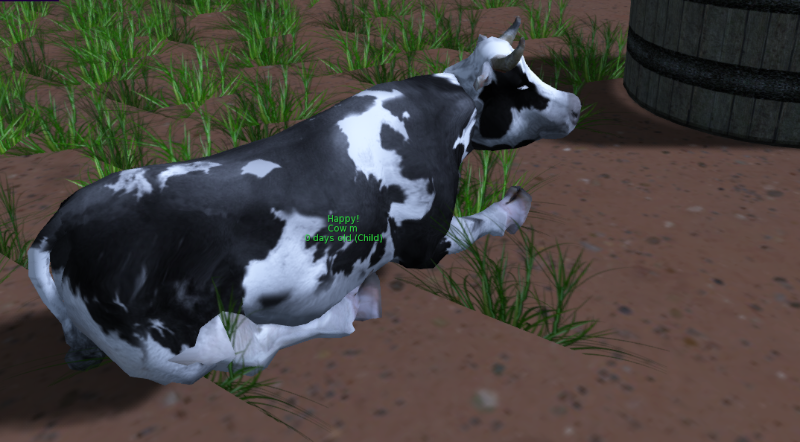
Observe que sua vaca pode ser de uma cor diferente - alguns animais têm & "genética"!
Quando seus animais se tornarem adultos, você pode acasalá-los para que possa optar por criar uma nova vaca antes dessa época!
Por padrão, o rezzer irá alternar entre produzir animais machos e fêmeas, mas você pode alterá-lo para ser aleatório se preferir no botão de opções.
Você também pode querer rez mais alguns animais - escolha entre cabras ou ovelhas (já que ambos podem comer do comedouro de grama).
Agora que você configurou sua fazenda básica, os animais comerão dos comedouros (que estão recebendo água da torre de água) e crescerão dia a dia até se tornarem adultos.
Parabéns, agora você é oficialmente um SatyrFarmer!

This work by Cnayl Rainbow is licensed under a Creative Commons Attribution-NonCommercial-ShareAlike 4.0 International License.
Based on a work at https://satyrfarm.github.io/




